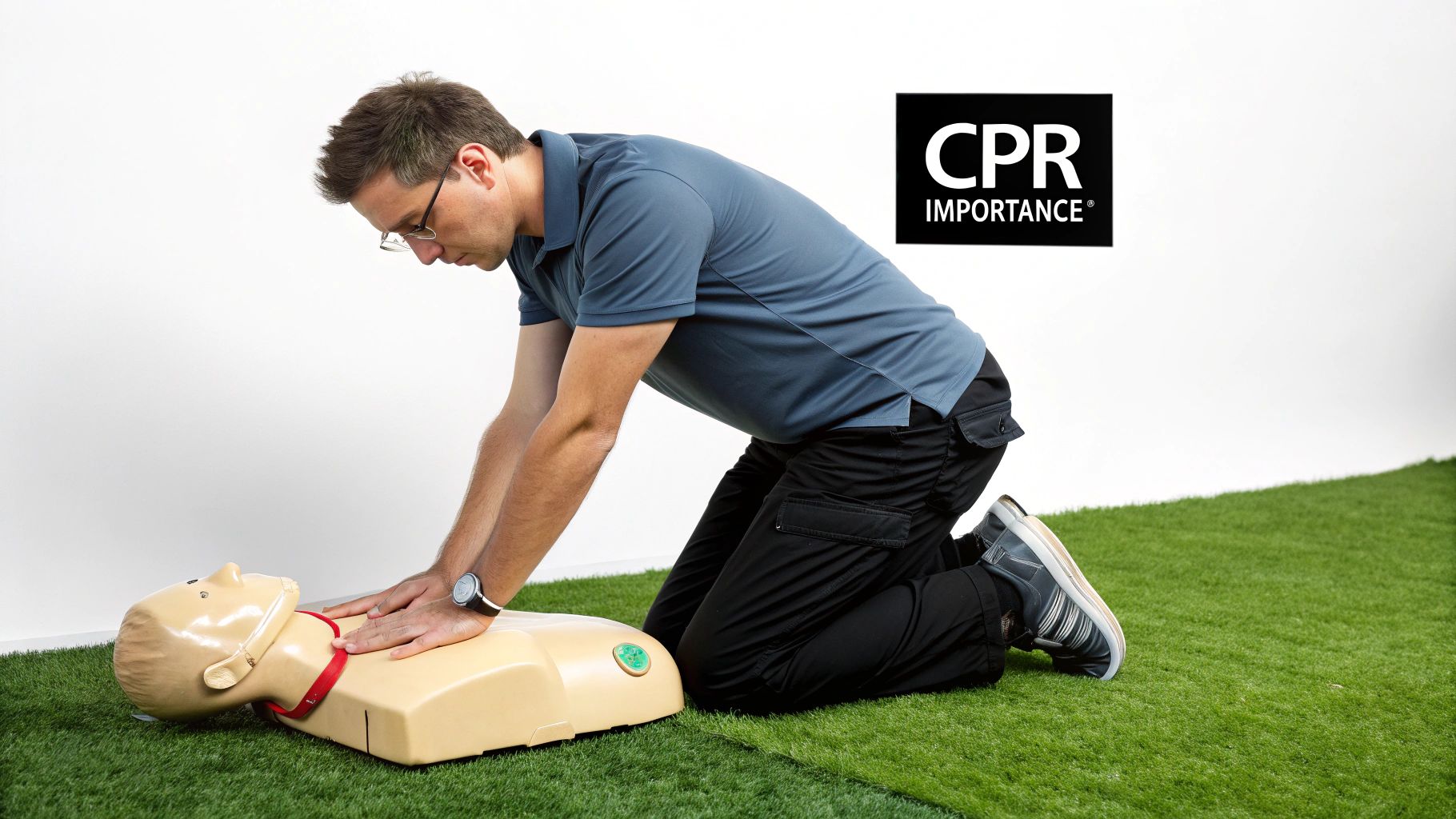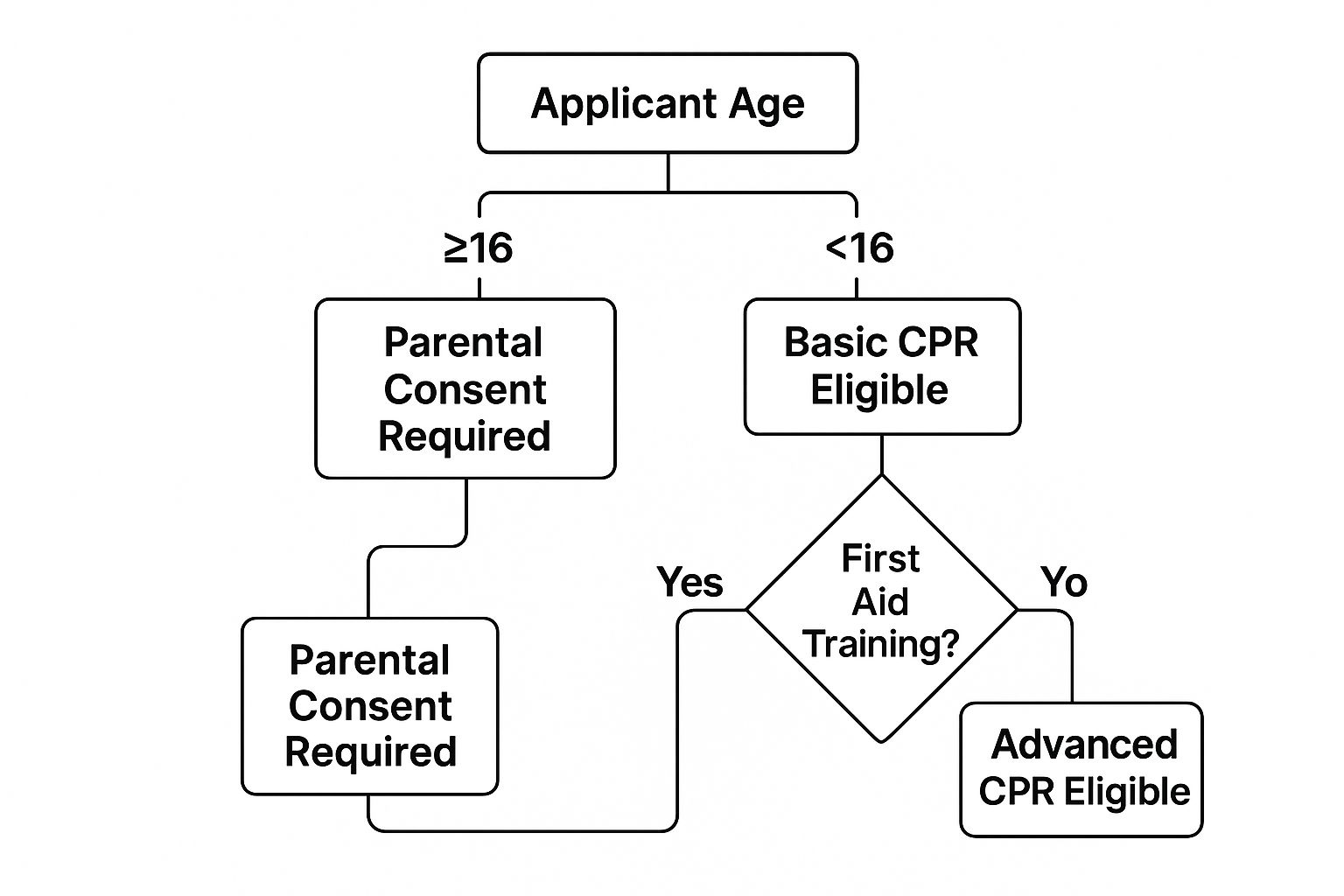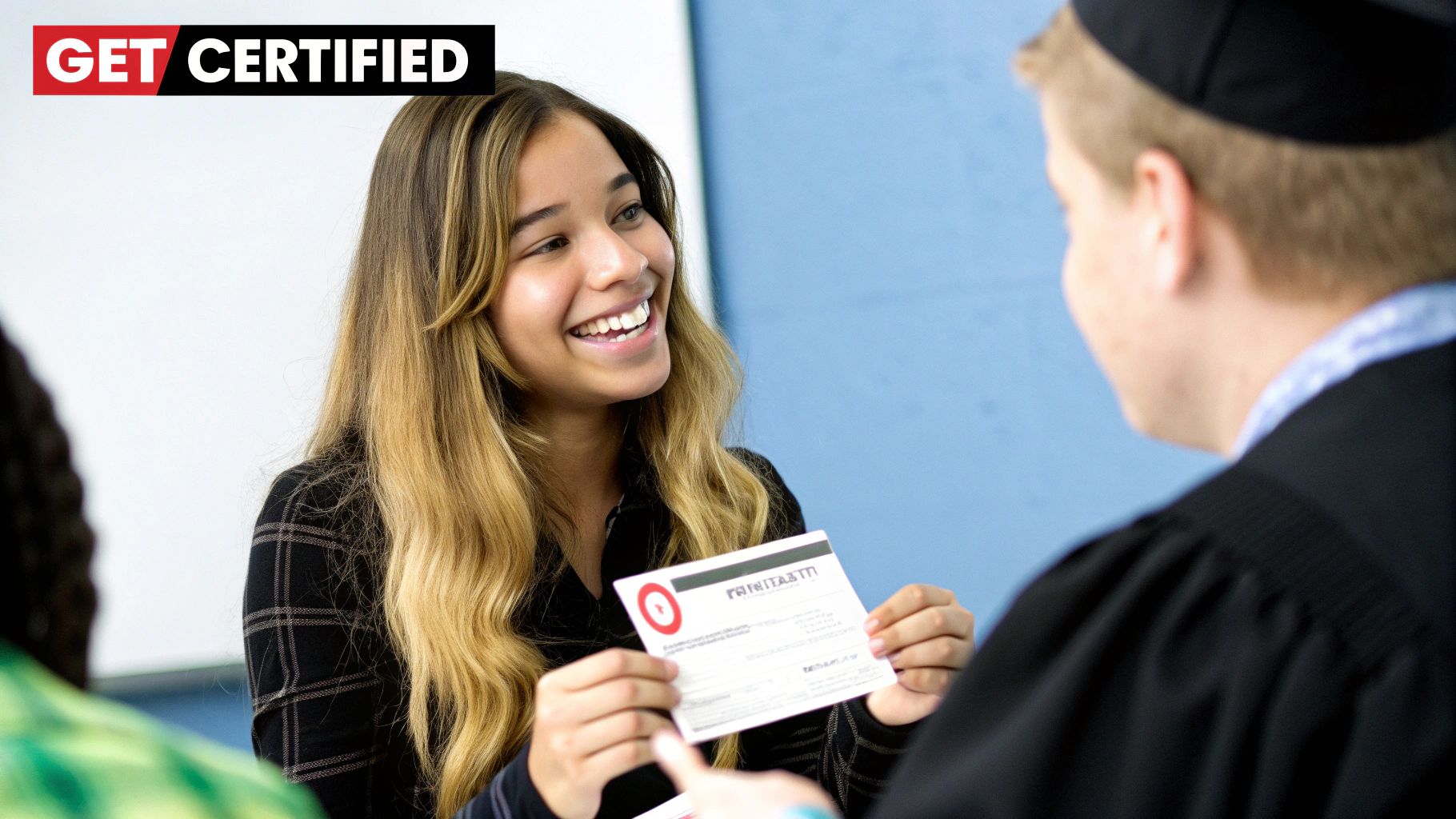Getting your CPR certification is a lot more straightforward than most people think. It really just boils down to three things: finding an accredited training provider, finishing the course, and passing a final test of your skills and knowledge.
This whole process is designed to give you the confidence—and the muscle memory—to actually step up and help in a real emergency.
Your Path to CPR Certification in a Nutshell

Deciding to get CPR certified is a powerful choice. It’s not just about ticking a box for a job requirement; it’s about being ready to make a life-or-death difference when every second is critical. In fact, immediate CPR from a bystander can double or even triple a person's chance of survival after cardiac arrest.
The best part? The process is built for everyone. You absolutely do not need a medical background to get certified and be effective. The whole point of a good CPR program is to break down what seems complex into simple, repeatable steps you can remember under pressure.
What to Expect From Your Training
Your training will be much more than just listening to a lecture. Any quality course, whether it's fully in-person or a blended online/in-person format, will have you practicing on manikins. This hands-on work is where you build the crucial muscle memory for chest compressions and rescue breaths.
You'll learn the proper rate and depth for compressions—something that's vital for keeping blood flowing to the brain and other organs until professional help arrives.
A common myth is that CPR is too complicated for the average person. The reality is that the core steps are intentionally simple. The real goal of certification isn't just to teach you the technique, but to build your confidence so you can act decisively instead of freezing up.
Modern CPR courses also cover how to use an Automated External Defibrillator (AED). These life-saving devices are showing up in more and more public places, and knowing how to use one is a key link in the "chain of survival." You’ll get comfortable with applying the pads and following the AED’s clear, calm voice prompts.
The Certification Process Simplified
To give you a clearer picture, here’s a quick summary of what the journey to certification usually looks like.
Of course, understanding the cost is a big part of the decision. For a complete look at what to budget, check out our guide on the cost of AEDs and CPR training.
Once you pass both the skills test and the written exam, you'll be issued a certification card from a nationally recognized organization like the American Heart Association or the American Red Cross. This certification is typically valid for two years.
Finding the Right CPR Course for Your Needs
First things first: not all CPR certifications are the same. Picking the right one is the most important step, and it all boils down to why you need it in the first place.
Are you a nurse who needs a specific Basic Life Support (BLS) certification to meet your hospital's requirements? Or maybe you're a new parent who just wants the peace of mind that comes with knowing what to do in an emergency at home? The answer changes everything.
The curriculum for a daycare provider is going to look a lot different than the one for an EMT. Getting this right from the start saves you time, money, and a lot of headaches.
This need for practical safety skills is growing everywhere. The global market for first aid and CPR training is massive—valued at around $4.34 billion in 2024 and expected to jump to $6.83 billion by 2029. It’s a clear sign that people worldwide are getting serious about being prepared.
Decoding the Different Course Levels
When you start searching for a class, you'll run into a bunch of acronyms, mostly from the American Heart Association (AHA) and the American Red Cross. They can seem confusing, but they generally fall into two main categories.
CPR/AED/First Aid: Think of this as the go-to course for most people outside of the medical field. It's perfect for teachers, coaches, construction workers, and anyone who wants to be a prepared bystander. You'll learn the essentials: adult, child, and infant CPR, how to use an automated external defibrillator (AED), and first aid for everyday injuries like cuts and sprains.
Basic Life Support (BLS): This is the one for healthcare professionals. If you're a nurse, doctor, paramedic, or dental assistant, this is your ticket. BLS training goes much deeper, covering high-performance CPR, how to work as part of a resuscitation team, and using advanced airway devices.

As you can see, age is a factor, but having some previous training can open the door to more advanced certifications if you're looking to build on your skills.
Choosing Your Learning Style: In-Person vs. Blended
Once you’ve figured out what course you need, the next question is how you want to learn. Most training centers offer a couple of different formats, each with its own pros and cons.
The best format is the one you'll actually complete and learn from. Be honest with yourself about your schedule, how you learn best, and what it will take for you to feel truly confident in an emergency.
1. Fully In-Person Training
This is the classic classroom setup. You get hands-on practice with manikins, direct feedback from your instructor, and the chance to ask questions the moment they pop into your head. If you’re a learn-by-doing kind of person, this is probably your best bet.
2. Blended Learning (Online + In-Person)
This hybrid option has become incredibly popular because it’s so flexible. You do all the bookwork and lectures online, on your own time. Then, you just show up for a shorter, in-person session to practice your hands-on skills and get tested. It’s the perfect mix of convenience and practical, real-world training.
3. Fully Online Courses
A quick word of caution here. While fully online courses can be great for refreshing your knowledge, they are almost never accepted for workplace or professional certification requirements. Why? Because they're missing the single most important part: the hands-on skills practice. For a closer look at these options, our guide on choosing the right CPR course breaks it down even further.
What Really Happens in a CPR Training Class

So you've signed up for a CPR class. It's totally normal to feel a bit nervous, but let me put your mind at ease. Walking into a modern CPR class isn't like walking into a stuffy, high-pressure exam. The atmosphere is surprisingly relaxed and supportive.
The instructor’s goal isn't to put you on the spot—it's to build your confidence, one skill at a time. Forget about a dry lecture. Today’s training is all about getting you moving, thinking, and practicing in a way that feels natural.
Core Skills You Will Master
The real heart of any CPR course is the hands-on practice. This is where the concepts click and you start building the muscle memory you’ll need if a real emergency ever happens. You'll be working with a CPR manikin, and the instructor will be right there guiding you.
You'll spend most of your time on these key skills:
- High-Quality Chest Compressions: This is non-negotiable and the most critical part of CPR. You’ll learn the right hand placement, how to achieve the proper depth (at least 2 inches for adults), and maintain a rate of 100-120 compressions per minute. Most instructors use fun tricks to help you lock in the rhythm, like tapping out the beat to "Stayin' Alive."
- Effective Rescue Breaths: Using a barrier device, you’ll practice giving breaths, learning how to get a good seal and deliver just enough air to see the chest gently rise.
- Operating an AED: The Automated External Defibrillator (AED) can seem intimidating, but it's designed to be used by anyone. You’ll get comfortable with the whole process: turning it on, applying the pads correctly, and simply following its clear voice commands.
This hands-on time is everything. I've seen it time and time again—the students who really engage with the manikins are the ones who leave feeling truly prepared.
Bringing It All Together with Realistic Scenarios
Once you've got a handle on the individual skills, the instructor will start stringing them together into realistic emergency scenarios. This is your chance to put everything into practice in a simulated, but safe, high-pressure situation.
Don’t worry about making mistakes here. In fact, we expect them! The classroom is the perfect place to get things wrong, ask "what if" questions, and get instant feedback so you can get it right when it counts.
A typical scenario might start with, "You're in the office breakroom and you see a coworker suddenly collapse." From that moment, you'll be guided to check the scene, assess the person, call for help, and start the sequence of CPR and using the AED, just like you would in real life. It’s this part of the training that really builds the confidence to act.
How to Get the Most Out of Your Class
A little preparation can make a huge difference in your experience. It really boils down to being comfortable and ready to engage.
Practical Tips for Class Day:
- Wear comfortable clothing. Seriously. You'll be on your knees, bending over manikins, and putting your back into compressions. Think gym clothes or anything that lets you move freely.
- Bring a drink and a snack. Classes can run for a few hours, and staying hydrated and fueled helps keep you sharp.
- Jump in and participate. Don't hang back. The more you ask questions, volunteer for demos, and interact with others, the more you'll absorb and remember.
Knowing what's coming helps you walk into your CPR class ready to learn. You’ll leave feeling not just certified, but genuinely empowered and prepared.
Passing Your Exam and Keeping Your Skills Sharp
Alright, you've made it through the course. Now for the final part: the test. I know, the word "test" can make anyone a little tense, but don't sweat it. The whole point of the evaluation is just to make sure you've locked in the core skills, not to trip you up.
It’s broken down into two simple parts: a quick written quiz and a hands-on skills check.
Think of the written part as a brief recap. It's usually a multiple-choice quiz that covers the "why" behind what you learned—things like the right compression-to-breath ratio, the steps for using an AED, and how to spot the signs of a cardiac emergency. Honestly, if you paid attention in class, you’ll probably find the questions feel more like a review than a test.
The Hands-On Skills Test
This is where you really get to show what you've learned. You'll perform CPR on a manikin, and an instructor will watch to see how you do. They're not looking for a Hollywood-perfect performance; they just need to see that you're proficient in the most critical life-saving actions.
They’ll be looking for a few key things:
- Correct Hand Placement: Are your hands right in the center of the chest?
- Proper Compression Depth: Are you pushing down at least two inches for an adult?
- Adequate Compression Rate: Are you hitting that sweet spot of 100-120 compressions per minute? (Think of the beat to the song "Stayin' Alive.")
- Full Chest Recoil: Are you letting the chest come all the way back up after each push? This is a big one people forget, but it's crucial for letting the heart refill with blood.
Your instructor genuinely wants you to pass. They give you feedback all through the class, so by the time you get to the skills test, you know exactly what they're looking for. Just relax, take a breath, and trust your training.
Keeping Your Certification and Skills Current
Getting that certification card is a huge accomplishment, but it's just the beginning. CPR is what we call a "perishable skill." If you don't practice it, the muscle memory and the confidence start to fade. That's why certifications from major bodies like the American Heart Association and the American Red Cross are only good for two years.
This isn't just a random rule; it's essential for making sure certified responders stay competent and ready to act. It's a global standard, too. A 2021 study found that while around 40% of people worldwide have had CPR training at some point, regular renewal is what really makes a difference in emergency readiness.
The good news is that recertification is much faster than the initial course. It’s usually a shorter "refresher" class that gets you caught up on any new guidelines and lets you practice your skills again. If you want to know more about what that involves, we have a whole guide on CPR and first aid renewal.
Staying current means you'll never have to second-guess yourself when every second counts.
The True Impact of Being CPR Certified

Sure, a lot of people get CPR certified because their job says they have to. But honestly, the real value of this skill goes way beyond checking a box for HR. It completely changes your role in an emergency, turning you from a helpless bystander into the person who can actually take charge when every single second counts.
Think about this: when someone goes into sudden cardiac arrest, their survival odds plummet by about 10% for every minute that ticks by without CPR. If you're on the scene and can start immediate, high-quality chest compressions, you can literally double or even triple their chance of survival.
That's not just a number. It's a powerful reminder of the incredible ripple effect one trained person can have.
The Confidence to Act
In a real crisis, hesitation is the enemy. It's that moment of freezing, of not knowing what to do, that costs precious time. A proper certification course doesn't just drill the steps into you; it builds the genuine confidence you need to walk into a chaotic scene, call for help, and start compressions without that paralyzing self-doubt.
This confidence bleeds into other parts of your life, too. You suddenly become a more prepared and reliable person at home, at your kid's soccer game, or just out in your community. You become the person who runs toward the problem, not away from it.
Getting certified gives you a profound sense of preparedness. It’s the quiet confidence of knowing that if the unthinkable happens, you have the skills to give someone their best possible chance at life.
Bridging the Gap Until Help Arrives
Paramedics are heroes, but they can't teleport. That time between the 911 call and the ambulance pulling up is a critical, terrifying window. Bystander CPR is what bridges that gap. You are keeping oxygen-rich blood flowing to the brain and other vital organs, holding the line until the professionals arrive.
Without it, irreversible brain damage can start in just a few minutes. Your actions as the first person to respond are what make a successful outcome possible for the EMS team that takes over. You are the first, and arguably most important, link in the chain of survival.
Unfortunately, far too few people are ready. A 2017 survey revealed that only 18% of U.S. adults were currently CPR certified. Even more sobering, less than a third of people who have a cardiac arrest get the bystander CPR they desperately need before EMS arrives. You can see the full story in the American Heart Association's in-depth research on bystander CPR rates.
Ultimately, learning how to become CPR certified is about so much more than getting a card for your wallet. If you want to dig deeper, check out our guide on getting your CPR and AED certification. It’s a true investment in the safety of your community and your own peace of mind.
Common Questions About CPR Certification
Deciding to get CPR certified is a big step, and it's totally normal to have a few questions before you sign up. I get these all the time from people just starting out. Let's clear up some of the most common ones so you can feel confident moving forward.
What Is the Difference Between CPR and BLS?
This is probably the number one question I hear. It’s easy to get them mixed up, but the distinction is pretty simple.
Think of CPR/AED/First Aid as the go-to for the general public. This is for teachers, parents, construction workers, and anyone who wants to be ready to help in an emergency. It covers the essential skills for helping an adult, child, or infant during a cardiac arrest, plus other critical situations like choking or severe bleeding.
Basic Life Support (BLS), on the other hand, is the professional-grade certification built for healthcare providers. We’re talking about nurses, doctors, EMTs, dental assistants, and medical students. BLS covers everything in a standard CPR class but dives deeper into team-based resuscitation, using a bag-valve-mask (BVM), and handling more complex airway problems you'd encounter in a clinical setting.
If you don't work in healthcare, a standard CPR course is almost always the right fit.
How Much Does CPR Certification Cost?
Cost is always a factor, and it can vary. The price tag depends on who’s teaching the class, your location, and whether you choose an in-person or blended format.
Generally, you can expect to pay anywhere from $50 to $120 for a high-quality CPR/AED certification from a trusted organization like the American Heart Association or the American Red Cross. Courses for healthcare providers, like BLS, usually fall on the higher end of that spectrum.
How Long Does a Typical CPR Class Last?
This really comes down to the format you pick. A classic, fully in-person CPR/AED course usually runs about three to four hours.
But if you have a packed schedule, blended learning is a game-changer. You’ll do the book-learning part online at your own pace, and then the hands-on skills session is much shorter—often just one or two hours. It’s a super popular option for a reason.
Is an Online-Only CPR Certification Legitimate?
This is a huge one, and the answer is critical. While you'll find plenty of fully online CPR courses advertised, they are almost never accepted for any workplace or professional requirement.
Why? Because real certification requires an in-person, hands-on skills check with a qualified instructor. You simply can't learn or prove you can do chest compressions and rescue breaths properly through a screen. Think of those online-only options as a quick knowledge refresher, not a substitute for a legitimate certification.
A lot of people worry about failing the class. It’s a common fear, but remember, the instructors are there to coach you to success. To put your mind at ease, you can learn all about what happens if you fail a CPR course and why it's not the big deal you might think.
At Ready Response, we empower you with the life-saving skills needed to act confidently in any emergency. Our hands-on, accredited CPR and First Aid training courses are designed for everyone, from individuals to entire workplace teams. With expert instructors and a focus on real-world preparedness, you'll leave our classes not just certified, but truly ready to make a difference. Explore our courses and find a class near you at https://readyresponsepa.com.
